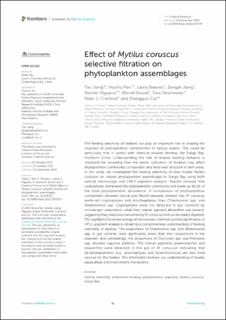| dc.contributor.author | Jiang, Tao | |
| dc.contributor.author | Pan, Huizhu | |
| dc.contributor.author | Steeves, Laura | |
| dc.contributor.author | Jiang, Zengjie | |
| dc.contributor.author | Filgueira, Ramón | |
| dc.contributor.author | Strand, Øivind | |
| dc.contributor.author | Strohmeier, Tore | |
| dc.contributor.author | Cranford, Peter J. | |
| dc.contributor.author | Cui, Zhengguo | |
| dc.date.accessioned | 2023-01-10T13:19:04Z | |
| dc.date.available | 2023-01-10T13:19:04Z | |
| dc.date.created | 2022-12-19T09:40:05Z | |
| dc.date.issued | 2022 | |
| dc.identifier.citation | Frontiers in Marine Science. 2022, 9 . | en_US |
| dc.identifier.issn | 2296-7745 | |
| dc.identifier.uri | https://hdl.handle.net/11250/3042375 | |
| dc.description.abstract | The feeding selectivity of bivalves can play an important role in shaping the structure of phytoplankton communities of natural waters. This could be particularly true in waters with intensive bivalves farming, like Sungo Bay, Northern China. Understanding the role of bivalve feeding behavior is important for assessing how the dense cultivation of bivalves may affect phytoplankton community composition and food web structure in farm areas. In this study, we investigated the feeding selectivity of blue mussel Mytilus coruscus on natural phytoplankton assemblages in Sungo Bay using both optical microscopy and HPLC-pigment analysis. Results showed that cryptophytes dominated the phytoplankton community and made up 66.1% of the total phytoplankton abundance. A comparison of phytoplankton composition between natural and filtered seawater showed that M. coruscus preferred cryptophytes and dinoflagellates than Chaetoceros spp. and Skeletonema spp. Cryptophytes were not detected in gut contents by microscopic observation, while their marker pigment alloxanthin was present, suggesting they were also consumed by M. coruscus and can be readily digested. This highlights the shortcomings of microscopic methods and the significance of HPLC-pigment analysis in obtaining a comprehensive understanding of feeding selectivity of bivalves. The proportions of Chaetoceros spp. and Skeletonema spp. in gut contents were significantly lower than their proportions in the seawater, and contrastingly, the proportions of Cocconeis spp. and Pinnularia spp. showed opposite patterns. The marker pigments prasinoxanthin and zeaxanthin were detected in the gut of M. coruscus indicating that picophytoplankton (e.g., prasinophytes and Synechococcus) are also food sources for this bivalve. This information furthers our understanding of bivalve aquaculture and environment interactions. | en_US |
| dc.language.iso | eng | en_US |
| dc.title | Effect of Mytilus coruscus selective filtration on phytoplankton assemblages | en_US |
| dc.title.alternative | Effect of Mytilus coruscus selective filtration on phytoplankton assemblages | en_US |
| dc.type | Peer reviewed | en_US |
| dc.type | Journal article | en_US |
| dc.description.version | publishedVersion | en_US |
| dc.source.pagenumber | 14 | en_US |
| dc.source.volume | 9 | en_US |
| dc.source.journal | Frontiers in Marine Science | en_US |
| dc.identifier.doi | 10.3389/fmars.2022.1070737 | |
| dc.identifier.cristin | 2094977 | |
| cristin.ispublished | true | |
| cristin.fulltext | original | |
| cristin.qualitycode | 1 | |
